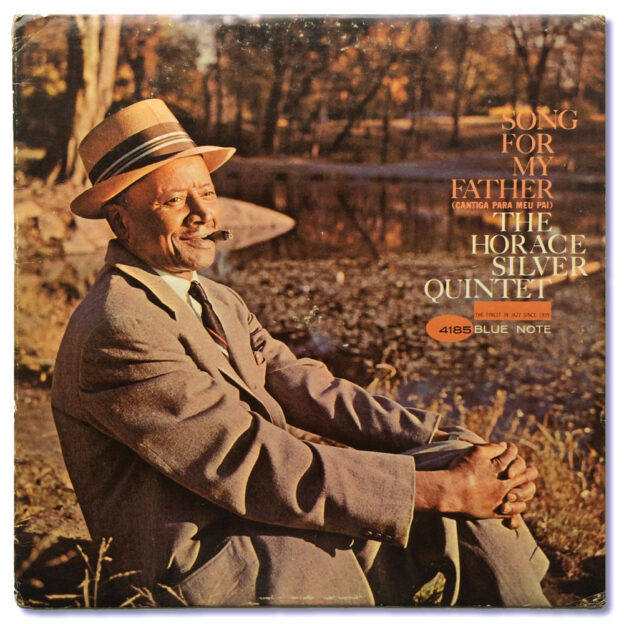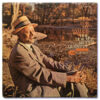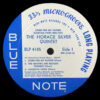- Original 1964 mono pressing
- “NEW YORK USA” on both labels
- Plastylite “P” etched and “VAN GELDER” stamped in dead wax
- Deep groove on side 1
- “43 West 61st St., New York 23” address on jacket without “Printed in U.S.A.”
Personnel:
All but “Calcutta Cutie”, “Lonely Woman”:
- Carmell Jones, trumpet
- Joe Henderson, tenor saxophone
- Horace Silver, piano
- Teddy Smith, bass
- Roger Humphries, drums
“Calcutta Cutie”, “Lonely Woman” only:
- Blue Mitchell, trumpet (“Calcutta Cutie” only)
- Junior Cook, tenor saxophone (“Calcutta Cutie” only)
- Horace Silver, piano
- Gene Taylor, bass
- Roy Brooks, drums
“Calcutta Cutie” and “Lonely Woman” recorded October 31, 1963
All other tracks recorded October 26, 1964
All selections recorded at Van Gelder Studio, Englewood Cliffs, New Jersey
Originally released December 1964
Selection: “Lonely Woman”
It makes sense that Song for My Father is part of many people’s introduction to the jazz genre. It is not only an essential part of the classic jazz canon, it is also a very accessible album. The minimalist structure of “Calcutta Cutie” and “Que Pasa” should cause just about anyone’s ears to perk up and listen. The album has everything: accessible tunes, a radio-friendly title track, two cooking sessions, and a gorgeous ballad. It certainly was one of the first albums I sought out. I first had the Rudy Van Gelder Edition CD, but when I started collecting jazz vinyl, this album was definitely near the top of my wish list.
The first time I came across an original pressing was at the Jazz Record Center in New York City. It was pretty exciting: I had just recently begun collecting and they had both original mono and stereo copies; I went for the mono. Though the record looked pretty darn clean when I bought it, to my dismay I later discovered that it suffered from audible groove wear. I bought another original mono copy on eBay with the same result before I got this copy via Buy It Now from a German seller. Although its visual condition is really only VG+, this copy is one of those rare instances where a vintage jazz record is scuffed up but free from groove wear and thus plays better than it looks.
My favorite song on this record is perhaps my favorite ballad of all time, “Lonely Woman”. It’s the last song on side 2, and because it’s the last song on the side I was faced with a particular dilemma. The phenomenon of inner groove distortion makes the innermost tracks on each side of a record more susceptible to groove wear, and this is exactly why my first two copies ended up for sale on eBay. Piano is an instrument especially prone to causing mistracing in the presence of groove wear, and on a ballad like this, that distortion is going to be easier to notice if it’s there. If you can find a Rudy Van Gelder-mastered original that’s free from groove wear like this one, the plus side to the engineer’s aggressive mastering techniques is that the music usually overpowers surface marks even in the most excessive of instances; listen above to hear the results.
Whereas my copy of this album has a deep groove on side 1 only, Fred Cohen’s Blue Note guide indicates that copies exist with deep grooves on both sides. But note that Cohen is very clear on page 77 of his guide when he explains the significance of deep grooves when evaluating the vintage of a Blue Note record:
“After a certain point, it can never truly be known whether similar pressings for the same record, whose only difference is the presence or absence of a deep-groove on one, both, or neither labels, is actually the original FIRST pressing. But since collectors have a natural bias for any detail that suggests an early or original issue, the presence of a deep-groove has been treated in this guide as an indication of an original, but ONLY an indication.”
Each of us is free to agree or disagree with him (I happen to think his scientific approach to the issue is exactly right) but I discourage the interpretation of the deep groove data in his guide as a definitive end-all-be-all as to what constitutes a first pressing for Blue Note albums released after the appearance of the first non-deep groove copies in 1961. There is no hard evidence suggesting that either deep groove or non-deep groove pressings of these albums always came first. For someone like myself, this means that in the event that all the other appropriate indicators are there, both deep groove and non-deep groove pressings should be considered first pressings. So if you have a copy of this album with the Van Gelder stamp and the “P” but no deep grooves, my advice is to consider it a first pressing.
The sound of this album is characteristic of Rudy Van Gelder’s work in the mid-1960s. As early as 1963 (see Lee Morgan’s The Sidewinder), one can hear Van Gelder pushing his compressors harder than ever, resulting in a saturated, thick sound. Horns meld together like glue, piano notes come thundering down like hammers, and drums have an in-your-face presence where each and every nuance is amplified to cut through the mix. Of the sides presented here, “Song for My Father” embodies this sound the most.
This album is a bonafide classic. It is yet another Blue Note staple filled with brilliant music, an album that beckons to be listened to from start to finish every time.








